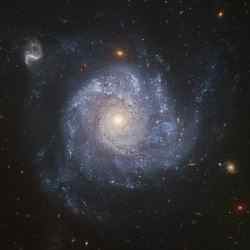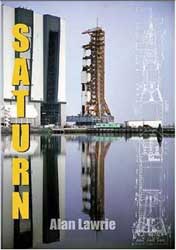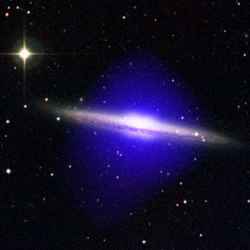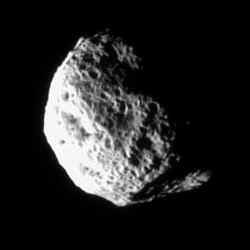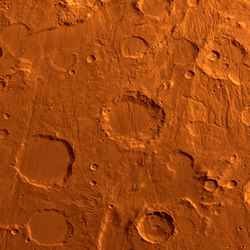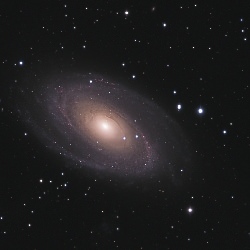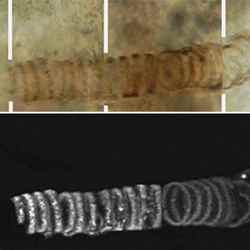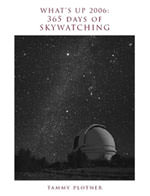
Download our free “What’s Up 2006” ebook, with entries like this for every day of the year.
|
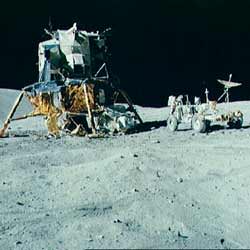
Apollo 16. Image credit: NASA. Click to enlarge.
Monday, February 6 – On this day in 1971, astronaut Alan Shepherd became the first “lunar golfer” to tee off on the Moon’s surface. While the Apollo 14 landing site is just on the other side of the terminator tonight, we can still go “crater hopping” to catch another. Close to the terminator and about one third of the way from the southern cusp are the ancient walls of huge previous studied Albategnius. Directly to its lunar east, and about the same distance as Albategnius’ is wide, look for a trio – small western Andel, larger eastern Descartes, and larger still southern Abulfeda. Power up! Between Andel and Descartes is the small pockmark of Dolland. North of Dolland is a ruined, unnamed crater with a pronounced set of rings on its northwestern shore. On the eastern edge of the relatively smooth floor, the remains of the Apollo 16 mission still shine on!
Tonight we’ll finish up our sweep for stardust through Auriga. Start at Theta and head due south five degrees (half a fist). On most nights, M37 gives an extraordinarily dense and complex view of more than 100 stars to small scopes, but lunacy will prevent that. Power up to darken the field.
Now let’s talk about these three interesting open clusters. All were discovered by Giovanni Batista Hodierna before the year 1654 – more than a decade before Messier cataloged them. All are located roughly 4000 light years away from Earth. The smallest of the three, M36, spans 12 light years. That’s not much more than the distance between our Sun and Epsilon Eridani. Larger M37 and M38 span about 25 light years, or about the distance between us and Vega. We’ll come back for a look at all three later in the month.
Tonight observers in western North America and Hawaii should follow the progress of the Moon as it passes through the Pleiades!
Tuesday, February 7 – On this day in 1889, the first American national astronomy organization was born – the Astronomical Society of the Pacific.
Tonight, let’s return to the Moon and previous study Plato. To the south on the dark plains of Mare Imbrium, you will notice an almost star-like point of light, a singular peak named Mons Pico. Unique among lunar mountains, its highly reflective rocky composition makes it appear almost like a pyramid in the long shadows of sunrise. “Pyramid” Pico stands 8,000 feet above the lunar plane on a base some 18 miles wide!
After looking at a solitary mountain this evening, let’s have a look at a solitary star as well – Alpha Orionis. Although its designation lists it as Orion’s brightest star in Johann Bayer’s Uranometria of 1603, Betelgeuse is actually slightly fainter than Beta (Rigel). What makes it special is its color. To the eye, Betelgeuse appears a distinctive red-orange. This color relates directly to its spectral class of M2. Like many M-spectra stars, Betelgeuse truly is a “red giant” – a star approaching the end of its life. With an immensely swollen, low temperature, near-vacuum photosphere of hydrogen and helium gas, this star measures some 300 million miles in diameter. Placed at the Sun’s position, it would extend out beyond the orbit of Mars! At 430 light years away, Betelgeuse is not the farthest or bright stars of winter, but it is most certainly the largest.
Wednesday, February 8 – Today celebrates the birth of J.L.E. Dreyer. Born in 1852, the Danish Dreyer came to fame as the astronomer who compiled the New General Catalogue (NGC) published in 1878. As a professional, Dreyer began his observations of the night sky in the employ of Lord Rosse at Birr Castle Ireland. Later Dreyer moved to Armagh Observatory where he confirmed many of the deep sky studies compiled by William Herschel and other observers using the 10″ refractor he secured funds for and selected as his instrument of choice. Even with a wealth of astronomical catalogs to choose from, the NGC objects, and Dreyer’s abbreviated list of descriptions, still remain the most widely used today.
Let’s engage is some further lunar exploration as crater Copernicus again becomes visible tonight to even the most modest of optical aid. Small binoculars show Copernicus as a bright “ring” midway along the lunar dividing line of light and dark called the “terminator.” Telescopes will reveal its 97 km (60 mile) expanse and 120 meter (1200 ft.) central peak to perfection. Copernicus holds special appeal as it’s the aftermath of a huge meteoric impact. At 3800 meters (12,600 feet) deep, its walls are around 22 km (14 miles) thick and over the next few days, the impact ray system extending from this tremendous crater will become wonderfully apparent.
Now, let’s explore something special from J.L.E’s lifework. Let’s turn eyes, binoculars, and scopes on Orion’s Belt and the brightly scattered open cluster NGC 1981. On a dark, moonless night, NGC 1981 can be seen unaided as a small, fuzzy haze in Orion’s “sword.” Let’s start by using binoculars – or finderscope – to get a sense of how 1981 “fits in” with the area. Do you see those three 6th magnitude stars at the top? They’re part of the 1981 cluster. Now look south to 4.6 magnitude 42 Orionis – a tight, disparate double. You probably won’t see M43 further south, but M42 will be visible. Try observing multiple system Iota Orionus. After the low power tour, head back to the top of the list with a telescope and enjoy the dozen or so brightly scattered, hot young stars that make up number 1981 on J.L.E Dreyer’s celestial list!
Thursday, February 9 – It’s a “Moon Gazer’s” evening as our nearest astronomical neighbor continues to light up the night sky. Don’t put away your telescopes and binoculars thinking there’s nothing to view though, because one of the most “romantic” features on the lunar surface will be highlighted tonight.
The Sinus Iridium is one of the most fascinating and idyllic regions of the Moon. At 241 km (150 miles) in diameter and ringed by the Juras Mountains, it’s known by the quiet name of “The Bay of Rainbows.” Despite this serene name, the region was actually formed by cataclysm. Astronomers speculate that a minor planet of around 200 km in diameter once impacted our newly formed Moon with a glancing strike. This caused “waves” of superheated material to wash up along a “shoreline” forming this delightful C-shaped lunar feature. The effect of looking at a bay is stunning as the smooth inner sands show soft waves called “rilles,” broken only by a few small, impact craters. This picture is completed as Promentoriums Heraclides and LaPlace rise above the surface (at 1800 meters and 3000 meters respectively) appearing as distant “lighthouses” standing at the entrance.
It’s also a great time for seeing double. Before it moves too high overhead, have a look at 41 Aurigae. The pair ? one of 5th and other of the 7th magnitude – is separated by 8 arc seconds. Notice how the companion orients almost due north of its brighter primary. The result appears as two stars moving side-by-side across the field of view! 41 Aurigae and it secondary are members of the Hyades. To locate 41, start at Beta Aurigae. Use your finderscope to center on Pi – a little more than a degree north. 41 is a slightly fainter star around five degrees northeast of Pi. It’s a challenge to locate – but it means is that you can congratulate yourself when you find it! And enjoy observing it all the more…
Friday, February 10 – Let’s return to the Moon tonight and explore an area to the south around another easy and delightful lunar feature – the crater Gassendi. At 110 km in diameter and 2010 meters deep, this ancient crater contains a triple mountain peak in its center. Once one of the most “perfect circles” on the Moon, the south wall of Gassendi has been eroded by lava flows over a 48 km expanse and offers numerous detailed features to telescopic observers on its ridge and rille covered floor. Observing with binoculars? Gassendi’s bright ring stands on the north shore of Mare Humorum…an area about the size of the state of Arkansas!
Are you ready for a tough double star? Alnitak (Zeta Orionis) is the easternmost star of Orion’s belt. It’s a double just wide enough to resolve through any telescope. However, you’ll need steady skies to show the two bright stars as distinct and tiny orbs of light separated by a mere 2.3 arc seconds. While observing this tight couple, keep in mind that both stars are some 800 light-years distant and that Zeta-A has one of the hottest photospheres among all known stars. At 31,000 degrees K, its temperature is so high that it shines primarily in the ultraviolet. Look for a third, 10th magnitude star almost 1 arc minute away from the bright pair. When you can see this one plainly, you’re ready to start looking for fainter members of the famed Trapezium found in the heart of M42.
Saturday, February 11 – On this day in 1970, Lambda 4S-5, the first Japanese satellite was launched.
The waxing Moon will dominate early evening skies, but tonight is an excellent opportunity for binoculars and telescopes to explore crater Tycho.
Named for Danish astronomer, Tycho Brahe, this fantastic impact crater is very impressive in even the most modest of optical aids. Spanning 85 km, this lunar feature will be very prominent and unmistakable in the southern hemisphere of the Moon. Tycho’s highly conspicuous ray system supports its origin as an impact crater. The rays span hundreds of kilometers across the lunar surface. Tycho is also one of the youngest of the major features at an astounding age of only 50,000,000 years old!
On January 9, 1968 Surveyor 7 – the last lunar robot of its kind – landed quietly at lunar sunrise on Tycho’s slopes. Because previous Surveyor missions provided the Apollo program with all data necessary for manned missions, Surveyor 7’s presence was scientific only. Two weeks later, when the Sun set on the landing site, Surveyor 7 had provided over 21,000 photographs, determined physical and chemical properties associated with the Southern Highland area, and detected laser beams aimed at it from two separate Earth observatories.
With the Moon lighting the skies, tonight will give you and opportunity to see just how much effect it has on studies. In the spirit of investigation, have a look at the Great Nebula in Orion. Not quite the glorious sight you remember, huh? But while in M42, power up a little and have a look at those four stars in its midst. We will be back…
Sunday, February 12 – Tonight the Moon will command the skies and give naked-eye observers an opportunity to use their imaginations!
Since the dawn of mankind, we have been gazing at the Moon and seeing fanciful shapes in large lunar features. Tonight, as the Moon rises, is your chance to catch an AL lunar challenge – “The Rabbit in the Moon.” The “Rabbit” is a compilation of all the dark maria. The Oceanus Procellarum forms the “ear” while Mare Humorum makes the “nose.” The “body” is Mare Imbrium and the “front legs” appear to be Mare Nubium. Mare Serenitatis is the “backside” and the picture is complete where Mare Tranquillitatis and Mare Fecunditatis shape the “hind legs” with Crisium as the “tail.”
See the Moon with an imaginative mind and new eyes — and find the “Rabbit.” It’s already out of the hat and in the heavens…
For telescopes and binoculars, the lunar surface will provide a bright but superior view of crater Grimaldi. Named for Italian physicist and astronomer, Francesco Grimaldi, this deep grey oval is one of the darkest features on the Moon – only reflecting about 6% of the light. Approximately 430 km (140-145 miles) long, it’s easy to spot along the terminator and just slightly south of the center of the lunar limb. Tonight is the best time to view its mountained walls, for later they will disappear and Grimaldi will take on the appearance of a small mare in the light of the full Moon.
Before then, let’s look at another fine double star – Eta Orionus. Eta is the 3.4 magnitude star a little over 6 degrees north-northeast of Rigel. Like Alnitak, Eta has a bright, closely spaced companion. Look for a much fainter 9.4 magnitude star that may not be part of the system. Like Alnitak, almost any size telescope can split the pair, but it will take a still sky to fully distinguish each star clearly.
May all your journeys be at light speed… ~Tammy Plotner. Contributing writer – Jeff Barbour @ astro.geekjoy.com
